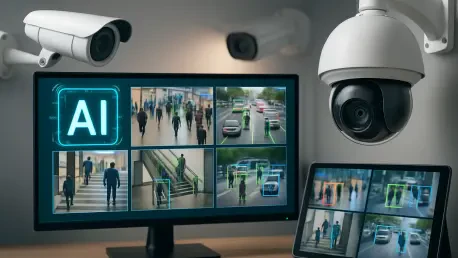As industries grapple with evolving security threats, artificial intelligence (AI) now stands as a pivotal force reshaping how video security systems operate. The incorporation of AI and machine learning into security infrastructure is driving a remarkable evolution, enhancing the ability to detect, analyze, and respond to incidents with unprecedented precision. This transformation not only addresses traditional security challenges but also paves the way for revolutionary solutions that redefine how organizations protect their assets. By integrating AI, security systems have moved beyond rudimentary functionalities, ushering in a new era of intelligent surveillance marked by real-time processing, adaptive algorithms, and scalable solutions. The impact of AI stretches across diverse sectors, setting new benchmarks for efficiency and effectiveness in security operations.
Deep Learning Takes Center Stage
Evolving Video Solutions
AI’s journey in security systems began with basic motion detection and object tracking capabilities, but today’s systems have transcended these elementary tasks to incorporate complex functions such as pose estimation and behavioral analysis. Pose estimation allows security cameras to interpret human actions, creating new possibilities for identifying suspicious behaviors and potentially dangerous situations before they escalate. Behavioral analysis can analyze patterns among crowds or identify deviations from expected conduct, providing insights that could prevent security breaches. The ability to predict anomalies and preemptively address potential threats epitomizes the sophisticated nature of AI-enhanced security systems. This level of advancement signifies a profound shift from reactive security measures to proactive strategies, where threats are anticipated and mitigated before they unfold.
Real-Time Processing and Privacy
One of the most significant advantages of AI-driven solutions lies in their capacity for real-time data processing. This capability allows security systems to immediately respond to threats, maintaining high data privacy standards by processing sensitive information on-site. Real-time processing not only mitigates risks associated with latency but also ensures compliance with stringent regulatory standards prominent across industries. The on-premises approach serves as a crucial safeguard, particularly for mission-critical applications where prompt responses are vital. Furthermore, privacy concerns are addressed through customized AI models that adapt according to specialized training data, ensuring that security measures do not compromise individual rights or regulatory compliance as systems evolve.
Building Flexible Video Management Platforms
Open Platforms: A Foundation for Integration
Open platform video management software (VMS) forms the backbone of AI-enhanced security systems, offering unrivaled flexibility for integrating numerous cameras and sensors into a cohesive surveillance network. This architecture enables centralized management and analysis of extensive datasets, empowering security teams to dynamically respond to emerging threats. The adaptability of VMS allows organizations to deploy new solutions swiftly and seamlessly, negating the need for extensive system overhauls. Such capability is paramount in modern security operations, where adapting rapidly to evolving threats is crucial. Open VMS platforms not only streamline management but also facilitate the integration of cutting-edge technologies, ensuring surveillance systems remain at the forefront of innovation.
Strategic Hardware Planning
With AI technologies continually advancing, security professionals must thoughtfully strategize hardware investments to optimize on-premises analytics. The growing complexity of AI algorithms necessitates robust computational capabilities to manage increasingly sophisticated data processing demands. Organizations must assess their infrastructure, accommodating future expansion to prevent prohibitive costs associated with frequent upgrades. Ensuring adequate processing power is integral to achieving and maintaining optimal performance of video security systems. Strategic planning in hardware infrastructure ensures that AI-enhanced systems can leverage the full potential of advanced analytics, thus driving efficiency without incurring excessive costs or disruption in operations.
Addressing Scalability and Sector-Specific Applications
Hybrid Models for Scalability
Scalability poses significant challenges, and many organizations are embracing hybrid models that incorporate on-premises and cloud elements. By maintaining critical real-time data on local servers, organizations have greater control and ensure low latency, which is vital for efficient security responses. Meanwhile, cloud services are leveraged for long-term storage and advanced analytics, enabling flexible scalability without compromising security principles. This innovative approach allows entities to expand processing power as needed, tailoring systems according to dynamic demands and specific security needs. Hybrid models reflect a strategic blend of control, efficiency, and technological expansion that optimizes security operations across varied sectors.
Practical Integration Across Industries
AI-enhanced video analytics are transforming practices across multiple sectors, providing insightful and actionable data that refines operations and enhances security. Retailers are using AI to optimize product placements and adeptly monitor customer behavior patterns to significantly reduce losses and maximize outreach. Educational institutions enhance safety through advanced video analysis that addresses issues such as vaping or bullying, creating a safer atmosphere congruent with safety protocols. AI analytics improve manufacturing by identifying safety violations, optimizing production, and streamlining quality control procedures. In hospitals and clinical environments, patient safety is bolstered through advanced monitoring and access controls, which are essential for ensuring compliance with established health protocols.
Navigating Deployment Challenges and Ethical Implications
Deployment and Initial Investment
Deploying smart analytic systems poses challenges that organizations must navigate, including significant upfront investments that might deter smaller entities or those with constrained budgets. Viewing these expenses as strategic long-term investments is critical, as the returns in enhanced security and operational efficiency often outweigh initial costs. Effectively managing the financial and logistical aspects of deployment ensures that organizations reap the full benefits of AI-enhanced security systems. Strategic planning can align investments with organizational goals, facilitating the smooth incorporation of sophisticated surveillance technologies without compromising financial stability.
Privacy and Ethical Considerations
The ethical dimension of AI in video security includes concerns such as privacy, consent, and potential algorithmic bias. Balancing powerful surveillance capabilities with privacy rights is essential for maintaining public trust and adhering to ethical standards. Policies surrounding data usage must be transparent, ensuring that AI systems support rather than undermine social good. Understanding the importance of responsible AI implementation involves addressing biases within algorithms and ensuring fair treatment through equitable decision-making processes. Establishing ethical guidelines reflects an organization’s commitment to upholding public trust, ensuring AI systems reinforce rather than detract from moral and societal values.
Paving the Way Forward
As artificial intelligence technologies continue to evolve, it becomes essential for security professionals to plan their hardware investments wisely to maximize on-premises analytics. The increasing complexity of AI algorithms demands robust computational power to handle sophisticated data processing efficiently. Organizations should thoroughly evaluate their existing infrastructure, ensuring it is scalable for future growth. This foresight can prevent the high costs and operational downtime that come with frequent system upgrades. Having sufficient processing capacity is crucial to maintaining the optimal performance of video security systems. Careful planning of hardware infrastructure allows AI-enhanced systems to fully utilize the potential of advanced analytics. This strategic approach not only boosts efficiency but also helps avoid excessive expenses and disruption to operations. By doing so, organizations can ensure that their security systems remain effective and competitive in an ever-changing technological landscape, laying a foundation for both current and future AI applications.









